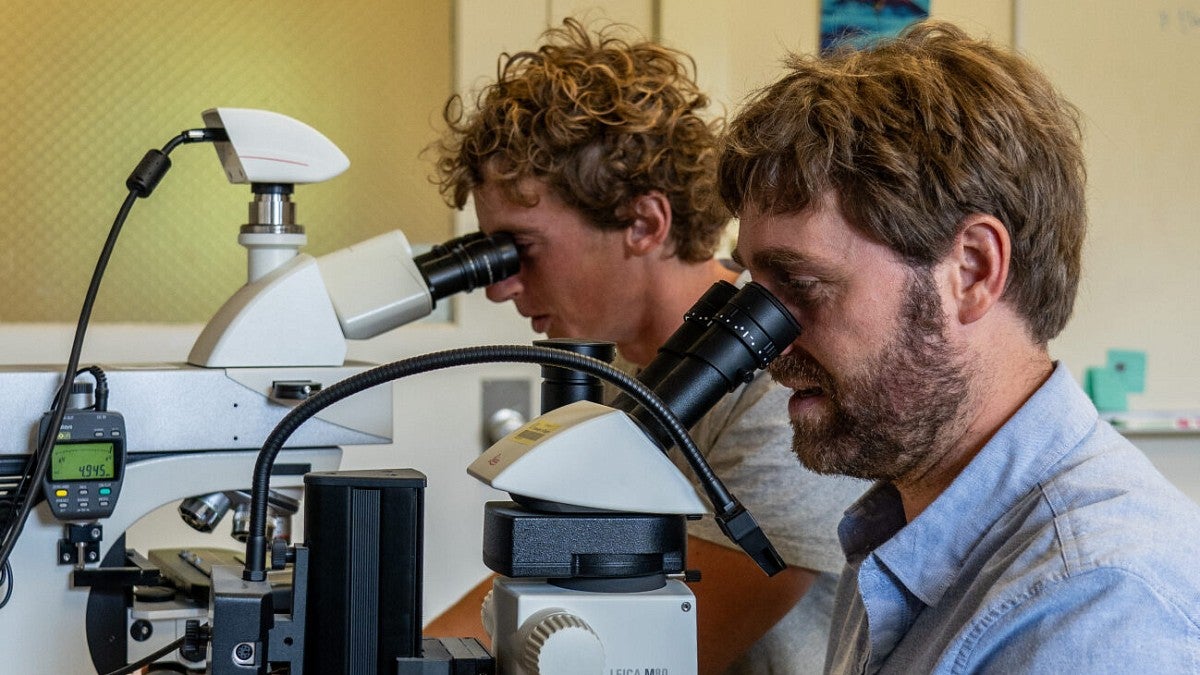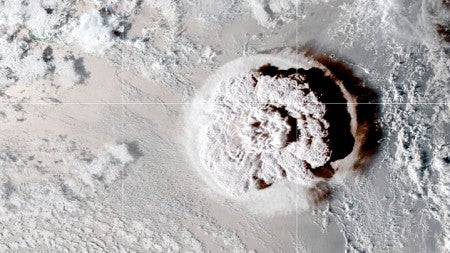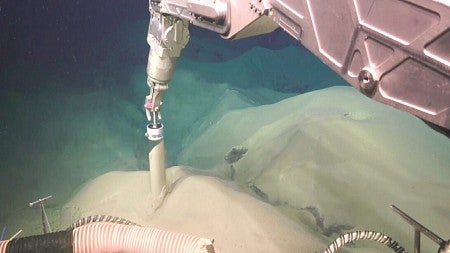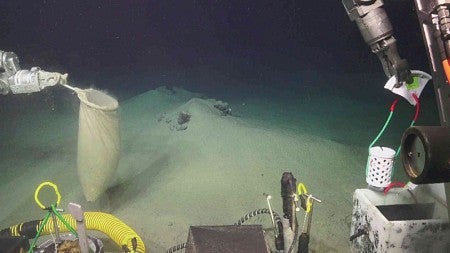
Experiential Learning | Research & Innovation | Community Impact | Career Preparation | Teaching Excellence | 21st Century Liberal Arts | Building Community | Good Vibes | CAS Spotlights | All Stories | Past Issues

Student Unearths Explosive Evidence
Nearly 500 feet below the surface of the southwestern Pacific Ocean, a volcano near the uninhabited island of Hunga Tonga-Hunga Ha'apai erupted in January 2022, spewing the highest plume of ash ever recorded and generating a tsunami that crossed the ocean.
Four months later and 62 miles away, University of Oregon student Marcus Chaknova was sailing around the Lau Basin with marine biologists from the College of Arts and Sciences’ Oregon Institute of Marine Biology and other universities, looking for snails and other organisms at hydrothermal vents—deep-sea hot springs where seawater and magma combine and enable a rare set of organisms to thrive without any sunlight.
But where they expected to find cinnamon roll-shaped snails, they instead saw up to 1.5 feet of fresh ash.
To most of the marine biologists on board, the ash was “just dirt in the way of their biological samples,” Chaknova says. But he had a volcanology background, and he knew what they’d found was much more valuable.
When opportunity knocks
Since the Hunga Tonga-Hunga Ha'apai’s eruption, researchers have only just begun to discover the extent its impact. Chaknova, who was an undergraduate student at the time, never expected to be one of those researchers.
But submarine samples of fresh volcanic ash are rare due to burrowing organisms and ocean currents that quickly mix old and new sediments. He knew it was up to him to make the most of the discovery.

With advice from the voyage’s principal investigators—Craig Young from OIMB, Roxanne Beinart from the University of Rhode Island and Shawn Arellano from Western Washington University—as well as geologists from around the world, Chaknova collected over 11 kilograms of ash from a dozen sites.
Eager to understand the samples in hand, he emailed Thomas Giachetti, a professor in the UO Department of Earth Sciences, to ask if he could make use of them.
“I am currently on a biological cruise near Hunga Tonga, and it has transformed into a rather geological cruise, to my surprise,” Chaknova wrote.
He also connected with researchers in Tonga and around the world, including people from the United States Geological Survey, the Tongan Geological Services and the Institute of Geological and Nuclear Sciences. Communicating with so many people in so many time zones was no easy task.
“I got a lot of advice from a lot of people, a lot of it contrasting one another,” he says. He had to choose which advice to follow, but he was up to the task.
“I was very impressed by how he handled all of that,” says Giachetti, who ultimately offered Chaknova a graduate position in his lab. His offer was just one of many.
“I didn’t think he would come here, honestly,” Giachetti says. But in the spring of 2023, Chaknova did.
Using research to help communities make decisions
Once Chaknova returned from the research cruise, he confirmed that the ash was from the Hunga Tonga-Hunga Ha'apai volcano through a geochemical analysis completed at the University of Rhode Island.
The next question was how the ash got to the sea floor—whether it fell from the volcanic plume or was transported through the fastest underwater flows ever recorded.
To find the answer, Chaknova and Giachetti used both biological and geological techniques. They studied which microfossils and plankton the ash contained and compared them to fossils found in different parts of the ocean to theorize how the ash got to the sea floor.

“You have to adapt and figure out how to make things work, and a lot of that comes down to using different disciplines to fit the puzzle pieces together,” Chaknova says.
Now, less than a year into his master’s and less than a year and a half after that pivotal voyage, Chaknova, Giachetti and their collaborators are preparing to publish their findings. They ultimately discovered that most of the ash was transported in just 24 hours through underwater flows from the volcano to the sites where Chaknova later found it. Some was also from ashfall, which likely finished settling around the time the research cruise arrived.
Chaknova will share his findings with the Tongan people to help them decide whether to allow deep-sea mining for minerals used in electric car batteries. Like submarine volcanoes, deep-sea mining disrupts sediment on the sea floor. Chaknova’s research can help them evaluate the potential impacts of deep-sea mining and make more informed decisions.
Because Chaknova collected the samples from Tongan waters, he says it is essential to address the questions that the Tongan people want answered.
“The next steps are up to them.”
—Vishva Nalamalapu is a communications intern for the College of Arts and Sciences.

Making Do with a 3D Printer and Hot Glue
While cruising around the Lau Basin, Chaknova needed sample cores to collect volcanic ash for later analysis. But there was a problem.
“We had next to no geological equipment on board,” he says.
He searched the entire ship for cores, an essential geological tool that preserves sediment layers. He was only able to find small cores without caps. Not easily discouraged, Chaknova and some engineers printed caps using a 3D printer onboard the research vessel and deployed a remotely operated vehicle to collect samples in the cores as well as in a canvas bag.
Chaknova then wanted to separate the samples by particle size using a sieve—another geological essential. There were no sieves. So he made some using PVC, mesh and hot glue.
The homemade sieves were far less efficient, but they got the job done.
“I ended up staying awake for almost three days straight one time, just sieving,” he remembers. The sieving left him covered in ash, earning him the nickname “dirt boy.”
